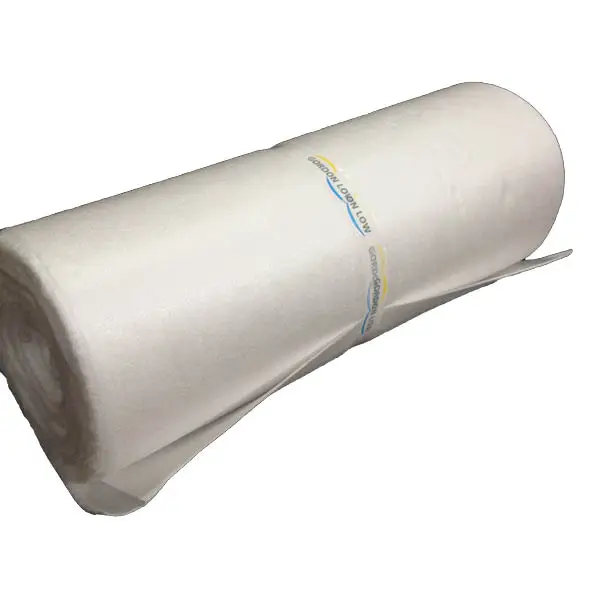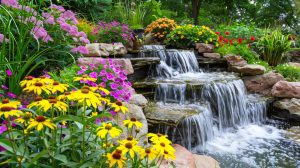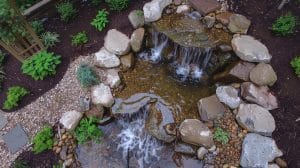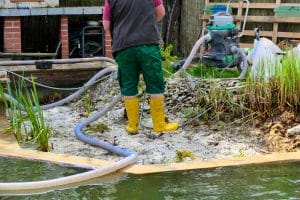
Pond Liner Underlay: Essential Protection for Your Aquatic Environment
Pond liner underlay plays a crucial role in maintaining the health and beauty of garden ponds. It acts as a protective barrier against sharp rocks, roots, and debris that could puncture the pond liner, potentially leading to costly repairs and a drained pond.
Choosing the right underlay not only prolongs the lifespan of the pond liner but also enhances the overall functionality of the pond.

When selecting pond liner underlay, factors such as weight, thickness, and material type should be carefully considered.
Different types of underlay can provide varying levels of protection and support, making it essential for pond owners to understand their options.
Proper installation and maintenance practices can ensure that the underlay continues to serve its purpose effectively through all seasons.
Pond liner underlay also contributes to the aesthetic appeal of a garden pond by providing a stable foundation. This foundation supports the design and functionality of the pond while promoting eco-friendly practices that benefit the surrounding environment.
By investing in quality underlay, pond owners can enjoy a beautiful, thriving pond for years to come.
Key Takeaways
- Pond liner underlay protects liners from punctures and damage.
- Selecting the right underlay enhances pond functionality and aesthetics.
- Quality installation and maintenance prolong the life of garden ponds.
Understanding Pond Liner Underlay
Pond liner underlay is a crucial component in the construction of garden ponds. It serves both protective and functional roles that enhance the longevity of pond liners.
This section explores its definition, purpose, and importance in garden pond setups.
Definition and Purpose
Pond liner underlay is a protective layer placed under the pond liner. It is typically made from durable materials, such as geotextiles, which are designed to resist punctures and abrasions.
The main purpose of this underlay is to protect the pond liner from sharp objects, like stones and roots, that might penetrate the liner.
Additionally, it helps absorb any ground movement, ensuring that the liner remains in place over time. The underlay also provides an insulation layer, which can help in maintaining water temperature.
Importance for Garden Ponds
Using pond liner underlay significantly impacts the success and longevity of garden ponds. Without it, the pond liner is more vulnerable to damage from sharp debris or ground settling.
Here are key benefits of using pond liner underlay:
- Increased Durability: The underlay extends the life of the pond liner by preventing tears and punctures.
- Ground Movement Protection: It reduces the risk of the pond liner shifting during ground movement, maintaining the pond’s shape.
- Enhanced Insulation: It provides insulation, helping to keep water temperature stable, which is essential for aquatic life.
Installing pond liner underlay is a smart choice for anyone looking to build a lasting and resilient garden pond.
Selecting the Right Pond Liner
Choosing the right pond liner is essential for ensuring a healthy aquatic environment and maintaining the integrity of the pond’s structure.
Factors like type, material, and size play a crucial role in this selection process. Understanding these elements helps in making an informed decision.
Types of Pond Liners
There are several types of pond liners available, each with its benefits. The most common types include PVC, rubber (EPDM), and butyl liners.
- PVC Liners: These are popular due to their affordability and ease of installation. They are flexible and can adapt to various shapes.
- EPDM Liners: This type is known for its durability and resistance to UV rays. They are also flexible, making them suitable for irregular pond shapes.
- Butyl Liners: Made from natural rubber, butyl liners are very flexible and long-lasting. They are ideal for wildlife ponds as they are non-toxic.
The choice depends on the specific needs and environment of the pond.
Materials and Durability
The material of the pond liner affects its longevity and performance. Each material has distinct characteristics:
- PVC: Generally lasts up to 10-15 years but can degrade in extreme temperatures.
- EPDM: Known for its superior durability, often lasting over 20 years if installed correctly. It can withstand temperature changes and UV exposure.
- Butyl: Offers excellent flexibility and resilience, lasting around 20 years.
Using an underlay with any liner type can significantly enhance protection, especially against sharp rocks and roots from the soil, ensuring longer lifespan and durability.
Pond Liner Calculator Utilisation
Using a pond liner calculator is an effective way to determine the correct size and amount of liner needed. This tool helps in estimating the surface area of the pond:
- Measure Dimensions: Define the shape of the pond, whether it’s circular, rectangular, or irregular.
- Input Measurements: Enter the dimensions into the calculator to get a precise measurement of the required area.
- Add Extra for Safety: Always include some extra material to allow for any mistakes or adjustments during installation.
By calculating the right amount, they can avoid waste and ensure a proper fit for their pond project.
Types of Pond Liner Underlay

Choosing the right pond liner underlay is essential for protecting the pond liner and ensuring its longevity.
There are various types of underlay materials available, each with specific advantages and uses. Understanding these options helps in making an informed choice.
Geotextile Underlay
Geotextile underlay is a popular choice for pond liners. It is made from durable, non-woven polypropylene. This type of underlay provides a strong protective barrier against sharp objects and uneven ground.
Many geotextile options come in various thicknesses, typically measured in grams per square metre (gsm).
For instance, a 200gsm underlay offers good protection in most environments.
This underlay permits water flow while preventing fine soil particles from blocking drainage. It also enhances the overall durability of the pond by reducing the risk of punctures.
When selecting geotextile underlay, consider the specific conditions of the pond site.
Rubber or Foam Alternatives
Rubber or foam alternatives serve as another option for pond liner underlay. These materials offer excellent cushioning for the pond liner. They help absorb pressure from the ground and create a barrier against punctures.
Rubber underlay is highly resilient and can handle high moisture levels, making it suitable for wetter areas.
Foam underlay, on the other hand, is lighter and easier to install, providing good cushioning without excess weight.
Both types of alternatives are effective in reducing the risk of wear and tear.
When selecting between these materials, the choice often comes down to personal preference and specific pond conditions.
Comparison of Underlay Materials
When comparing different types of pond liner underlay, several factors should be considered, such as durability, water permeability, and installation ease.
- Geotextile: Durable and allows water drainage. It is ideal for rocky or uneven surfaces, providing a good balance between cost and performance.
- Rubber: Resilient and suitable for moist areas. It provides excellent puncture resistance, but may be more expensive.
- Foam: Lightweight and easy to handle. It offers good cushioning but may not be as durable under extreme conditions.
Ultimately, the best type of underlay will depend on the pond’s location, depth, and surrounding environment. Choosing wisely can greatly enhance the life of the pond liner.
Installation of Pond Liner and Underlay

Installing a pond liner with underlay involves careful preparation to ensure a successful setup.
Key tasks include preparing the pond bed, applying the underlay, and positioning the pond liner. Each step is crucial for creating a stable, protected environment for the pond.
Preparing the Pond Bed
Preparing the pond bed is vital for a successful installation.
The first step involves digging the pond to the desired depth and shape. It’s important to check for sharp objects like rocks, stones, and roots that could damage the liner.
Once the pond is dug, the bottom should be smoothed out.
Removing any protruding stones or sharp pieces will help reduce the risk of punctures. If necessary, a layer of soft sand can be added to help level the bottom and further cushion the liner.
This preparation is crucial for a long-lasting pond.
Applying the Underlay
The underlay serves as a protective barrier between the pond liner and the ground. It shields the liner from sharp objects and provides additional support.
When applying the underlay, it should be rolled out across the entire pond bed.
Ensure the underlay overlaps by 3-4 inches in areas where multiple pieces are used. This helps cover any gaps and prevents exposure.
For added protection, consider layering the underlay in areas where the ground may be uneven or rocky.
Using quality underlay will be essential for minimising the risk of future damage to the pond liner.
Positioning the Pond Liner
Once the underlay is secure, it’s time to position the pond liner.
The liner should be unrolled carefully over the underlay, ensuring that it covers the entire area.
It’s essential to allow the liner to relax and settle into the contours of the pond.
Begin by smoothing out any wrinkles or folds, as these can create weak points.
The edges of the liner should extend beyond the pond’s edge, allowing for adjustments later.
Ensure that the liner is not resting on any sharp objects beneath it.
Taking time with this step helps ensure the longevity of the pond liner and the overall health of the pond.
Protecting Against Punctures

Protecting a pond liner from punctures is crucial for maintaining a healthy pond environment.
Sharp roots, rocks, and other debris can cause damage if not properly managed. This section will discuss how to identify risk areas, use effective cushioning techniques, and perform maintenance to prevent damage.
Identifying Risk Areas
The first step in protecting a pond liner is to identify areas that pose a risk for punctures.
Sharp roots, rocks, and other debris present in the ground can easily pierce the liner.
Inspect the soil before installation.
Areas with a lot of vegetation may hide roots that can grow and press against the liner.
Additionally, rocky soil can cause significant issues.
If any rocks are found, they should be carefully removed to reduce the risk of damage.
It is also wise to consider the placement of the pond.
Areas prone to flooding may shift materials, exposing the liner to potential puncture risks.
Taking the time to assess these areas can save considerable effort later.
Cushioning Techniques
Using the right underlayment material is essential for providing a cushion between the pond liner and the ground.
Geotextile fabric or rubber underlay can effectively prevent punctures by absorbing the weight of the water and diffusing pressure.
A thickness of at least 5mm is recommended for sufficient protection.
Additionally, carpet padding may serve as an alternative, providing extra cushioning against debris.
When setting up the liner, ensure that the underlay covers the entire base area and extends slightly beyond the perimeter of the pond.
This extra coverage creates an additional barrier against rocks and roots, ensuring that the liner remains intact over time.
Maintenance to Prevent Damage
Regular maintenance is key to prolonging the life of a pond liner.
After installation, periodic checks should be carried out to inspect for any signs of damage or threats.
Clear the area around the pond of any debris, including fallen branches or leaves.
This not only beautifies the pond but also prevents sharp objects from accumulating and pressing against the liner.
Regularly check on the soil and look for any new root development near the pond edge.
If roots are found, they should be pruned back to avoid contact with the liner.
Maintenance and Care
Proper maintenance and care of pond liner underlay ensures its effectiveness and longevity.
Regular checks, prompt repairs, and long-term management are essential for protecting the integrity of both the underlay and the pond liner itself.
Regular Inspections
Inspections should be performed at least twice a year, ideally in spring and autumn.
During these inspections, one should look for signs of wear or damage.
Clear debris and check for punctures or tears in the pond liner and underlay.
Key inspection points include:
- Surface integrity: Ensure the underlay is intact and free from folds or sharp objects.
- Moisture levels: Look for any unusual damp spots which may signal leaks.
- Weed growth: Remove any plants that may disturb the underlay.
Repairing Minor Damage
If minor damage is found, such as small punctures or tears in the underlay, it is vital to act quickly.
Use a patch repair kit specifically designed for pond liners.
Steps to repair damage:
- Clean the area around the damage to ensure a good seal.
- Apply adhesive from the patch kit to both the patch and the damaged area.
- Press the patch firmly in place and allow it to cure as per the instructions.
Long-Term Underlay Care
Long-term care of the pond liner underlay includes maintaining its protective qualities.
Avoid walking on the underlay when possible to prevent indentation or puncturing.
Maintenance tips:
- Ensure proper drainage to prevent water accumulation under the liner, which can weaken its structure.
- Regularly replace any damaged sections promptly to maintain the barrier function.
- Consider periodic replacements of the underlay if it shows signs of degradation over time.
Weight and Thickness Considerations
When choosing a pond liner underlay, weight and thickness play crucial roles in its effectiveness.
Proper underlay supports the liner, protects it from damage, and ensures the longevity of the pond.
200gsm Underlay
A popular choice for pond underlay is 200gsm fabric. This weight strikes a balance between durability and flexibility.
At 200 grams per square metre, this underlay offers excellent puncture resistance against sharp rocks and roots in the ground.
Using a 200gsm underlay helps to prevent tears in the pond liner when the pond is filled with water.
It also provides cushioning that can adapt to ground movement over time.
This adaptability can significantly enhance the longevity of both the underlay and the liner, making it a wise investment for any garden pond.
Assessing the Adequate Thickness
The thickness of pond underlay is essential for optimal protection.
Generally, thicker underlays offer better protection, but the right choice depends on specific factors.
For standard garden ponds, a thickness in the range of 8mm to 12mm is often sufficient.
A heavier underlay may be required for larger ponds or those in high-traffic areas.
It is also advisable to assess the ground condition.
If the ground has sharp rocks or debris, selecting a thicker underlay will provide extra security against potential damage.
Choosing the correct thickness can save money in the long run by reducing the need for repairs or replacement.
Designing for Aesthetics and Functionality
When creating a garden pond, the design should balance both aesthetics and functionality.
Thoughtful choices in contouring, landscaping, and materials can enhance the visual appeal while ensuring the pond works effectively.
Contouring and Landscaping
Contouring is crucial in pond design. It involves shaping the land around the pond to create a natural look.
Smooth lines and gentle slopes can help blend the pond into the garden.
Using materials like rocks can enhance this effect. Placing larger stones around the edges can create a seamless transition from water to land.
Smaller stones or gravel can be added to mask the edges of the pond liner, contributing to a more organic appearance.
Additionally, plants play a key role.
Aquatic and marginal plants not only add beauty but also support the ecosystem.
They can soften harsh edges and provide habitats for wildlife.
Choosing a mix of heights and colours will make the pond visually appealing throughout the seasons.
Visibility of Liners and Underlay
Liners must be carefully considered to maintain the pond’s aesthetic.
High-quality pond liners are essential for preventing leaks while being hidden from view.
It’s important to select a liner that can withstand sunlight and temperature changes.
The underlay serves a supportive function. It protects the liner from punctures caused by rocks or roots.
Using a soft, durable material ensures the liner remains intact over time.
To minimise visibility, the edges of the liner can be covered with decorative stones.
This not only enhances the look but keeps the pond tidy.
The liner’s colour can also be chosen to blend with the surroundings, making it less noticeable while fulfilling its necessary functions.
Eco-Friendly Practices
Using eco-friendly practices is essential when considering pond liner underlay.
These approaches focus on sustainable materials and reducing environmental impacts. Implementing these practices can enhance the benefits of garden ponds while being mindful of the ecosystem.
Sustainable Materials
Choosing sustainable materials for pond liner underlay is crucial for environmentally conscious pond construction.
Geotextile fabrics are a popular choice as they are durable and support water drainage while preventing soil erosion.
These materials often come from recycled sources, which helps reduce waste.
Some pond liners use recycled rubber, which is made from repurposed tyres.
This not only minimises landfill waste but also provides a robust layer that can withstand harsh environmental conditions.
Environmental Impact Reduction
Reducing environmental impact starts with selecting appropriate underlay materials that limit harm to ecosystems.
Using high-quality, permeable geotextile helps maintain proper drainage and prevents harmful chemicals from leaching into the garden.
This is especially important for supporting local wildlife.
Furthermore, filling ponds with rainwater rather than tap water can also lessen the environmental impact.
Rainwater is free from the chemicals often found in tap water that can disrupt pond ecosystems.
By implementing these practices, pond owners can create a thriving habitat while being responsible stewards of the environment.
Cost-Effectiveness
Considering cost-effectiveness is essential when choosing pond liner underlay.
It involves assessing affordable options and how the longevity of the material relates to the initial investment.
Affordable Options
Various types of pond liner underlay are available, catering to different budgets.
For example, geotextile underlay is often used due to its balance between cost and effectiveness. It protects the pond liner from sharp objects like rocks and roots.
PVC underlay is another budget-friendly choice that is widely available.
While cheaper options like polyethylene may exist, they often lack the durability needed for long-term use.
Investing in a reliable underlay ensures fewer repairs and replacements in the future.
Thus, the right choice may ultimately save money in pond maintenance.
Longevity Versus Initial Investment
When selecting a pond liner underlay, it’s vital to weigh longevity against the upfront costs.
Higher-quality materials, such as heavy-duty rubber or advanced geotextiles, may have a greater initial price but offer superior durability.
These longer-lasting options provide better protection for pond liners, reducing the likelihood of damage from environmental factors.
This means fewer repairs or replacements, translating into savings over time.
It’s essential to consider the specific needs of the pond.
If a pond has many sharp stones or heavy plant roots, spending more on a robust underlay can prevent expensive issues down the line.
Thus, a well-considered investment pays off in the long run.
Getting Expert Advice
Seeking expert advice can help ensure that the installation of pond liner underlay is done correctly.
Professionals can offer insights that prevent costly mistakes. Various resources and online support options are also available to assist with proper guidance.
When to Consult a Professional
It is wise to consult a professional when planning a new pond or renovating an existing one.
If there are concerns about soil conditions or if local wildlife may impact the pond, an expert can assess these factors.
Professionals can also advise on the type and thickness of underlay needed.
This advice is crucial for avoiding future issues like punctures or stretching.
If the pond’s design involves complex shapes or depths, expert input can ensure that the liner fits perfectly, reducing risks.
Resources and Online Help
Various resources are available for those seeking help with pond liner underlay.
Websites such as gardening forums or specialist pond construction sites often contain valuable information.
Many of these platforms allow for direct interaction, where individuals can ask specific questions.
In addition to online articles, users should consider reaching out via email to industry experts.
Many businesses offer consultations or quick responses to queries regarding products and installation.
Video tutorials can also provide visual guidance on proper techniques.
These resources can greatly enhance understanding and execution of the project.



